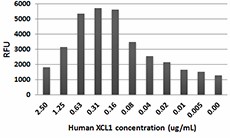- Regulatory Status
- RUO
- Other Names
- Lymphotactin, Ltn, ATAC, SCYC1, SCM-1, SCM-1a, lymphotaxin
- Ave. Rating
- Submit a Review
- Product Citations
- publications

-

Human XCL1 chemoattracts Baf3-hXCR1 transfectants in a dose dependent manner.
| Cat # | Size | Price | Quantity Check Availability | Save | ||
|---|---|---|---|---|---|---|
| 758004 | 25 µg | 265 CHF | ||||
XCL1, also known as lymphotactin, is an inflammatory chemokine secreted by T cells and natural killer (NK) cells. Early reports described XCL1 as a mediator of T cell and NK cell migrations, but recent studies suggest a highly specialized role for XCL1 and its receptor XCR1. The XCL1-XCR1 axis has been shown to play an important role in dendritic cell mediated cytotoxic immune response and in the formation of self-tolerance mechanisms through the development of regulatory T cells within the thymus. XCL1 also acts as a conformation-dependent inhibitor of HIV-1. Unlike other chemokines, XCL1 conformation interchanges between conserved chemokine folds and an unrelated dimeric structure under physiological conditions. The XCL1 monomer binds XCR1 with a high affinity, whereas the dimer form binds glycosaminoglycan (GAG) with high affinity, but fails to activate XCR1. Human XCL1 encodes a 114 amino acid precursor protein with a 21 amino acid signal peptide and a single disulfide bond.
Product DetailsProduct Details
- Source
- Human XCL1, amino acids (Val22-Gly114) (Accession# P47992), was expressed in E. coli.
- Molecular Mass
- The 93 amino acid recombinant protein has a predicted molecular mass of approximately 10.3 kD.
- Purity
- >98%, by SDS-PAGE, HPLC, MALDI-MS, and NMR.
- Formulation
- Lyophilized powder.
- Endotoxin Level
- Less than 1.0 EU per µg of protein as determined by the LAL method.
- Storage & Handling
- Unopened vial can be stored at -20°C or -70°C. For maximum results, quick spin vial prior to opening. Reconstitute in water to a concentration of 0.1-0.5 mg/ml. Do not vortex. It is recommended to further dilute in a buffer containing a carrier protein such as 0.1% BSA and store working aliquots at -20°C to -80°C. Avoid repeated freeze/thaw cycles.
- Activity
- ED50 = 0.02 - 0.1 µg/mL as measured by its ability to chemoattract BaF3 mouse pro B cells transfected with human XCR1.
- Application
-
Bioassay
Antigen Details
- Structure
- Monomer and Dimer.
- Distribution
-
Spleen, peripheral leukocytes, CD4+ and CD8+ T cells, and natural killer (NK) cells.
- Function
- T cell and NK cell recruitment.
- Interaction
- T cell, NK cell, and Dendritic cells.
- Ligand/Receptor
- XCR1.
- Bioactivity
- Chemoattract BaF3 mouse pro B cells transfected with human XCR1.
- Biology Area
- Immunology
- Molecular Family
- Cytokines/Chemokines
- Antigen References
-
1. Kelner GS, et al. 1994. Science 266(5189):1395-9.
2. Kennedy J, et al. 1995. J. Immunology 155:203-209.
3. Volkman BF, et al. 2009. Methods Enzymol. 461:51-70.
4. Lei Y, Takahama Y. 2012. Microbes Infect. 14(3):262-7.
5. Guzzo C, et al. 2013. PLoS Pathog. 9(12):e1003852.
6. Kroczek RA, Henn V. 2012. Front Immunol. 3:14. - Gene ID
- 6375 View all products for this Gene ID
- UniProt
- View information about XCL1 on UniProt.org
Related FAQs
- Why choose BioLegend recombinant proteins?
-
• Each lot of product is quality-tested for bioactivity as indicated on the data sheet.
• Greater than 95% Purity or higher, tested on every lot of product.
• 100% Satisfaction Guarantee for quality performance, stability, and consistency.
• Ready-to-use liquid format saves time and reduces challenges associated with reconstitution.
• Bulk and customization available. Contact us.
• Learn more about our Recombinant Proteins. - How does the activity of your recombinant proteins compare to competitors?
-
We quality control each and every lot of recombinant protein. Not only do we check its bioactivity, but we also compare it against other commercially available recombinant proteins. We make sure each recombinant protein’s activity is at least as good as or better than the competition’s. In order to provide you with the best possible product, we ensure that our testing process is rigorous and thorough. If you’re curious and eager to make the switch to BioLegend recombinants, contact your sales representative today!
- What is the specific activity or ED50 of my recombinant protein?
-
The specific activity range of the protein is indicated on the product datasheets. Because the exact activity values on a per unit basis can largely fluctuate depending on a number of factors, including the nature of the assay, cell density, age of cells/passage number, culture media used, and end user technique, the specific activity is best defined as a range and we guarantee the specific activity of all our lots will be within the range indicated on the datasheet. Please note this only applies to recombinants labeled for use in bioassays. ELISA standard recombinant proteins are not recommended for bioassay usage as they are not tested for these applications.
- Have your recombinants been tested for stability?
-
Our testing shows that the recombinant proteins are able to withstand room temperature for a week without losing activity. In addition the recombinant proteins were also found to withstand four cycles of freeze and thaw without losing activity.
- Does specific activity of a recombinant protein vary between lots?
-
Specific activity will vary for each lot and for the type of experiment that is done to validate it, but all passed lots will have activity within the established ED50 range for the product and we guarantee that our products will have lot-to-lot consistency. Please conduct an experiment-specific validation to find the optimal ED50 for your system.
- How do you convert activity as an ED50 in ng/ml to a specific activity in Units/mg?
-
Use formula Specific activity (Units/mg) = 10^6/ ED50 (ng/mL)
 Login / Register
Login / Register 








Follow Us